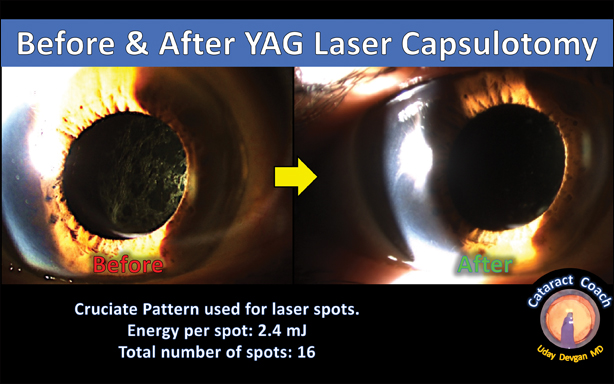Two techniques effective for YAG laser capsulotomy
Some surgeons prefer either the cruciate pattern technique or the circular pattern technique, while others tailor the procedure to the patient.
Posterior capsule opacification, or PCO, is common after cataract surgery, especially after a few years have passed. Even a perfect surgery by a master surgeon still leads to PCO in many cases. Fortunately, we have the ability to use the YAG laser to perform a posterior capsulotomy, which is safe and highly effective and takes just a few minutes. Because of the high prevalence of PCO, every cataract surgeon needs to know how to perform an effective YAG laser capsulotomy.
The two primary techniques are the cruciate pattern and the circular pattern, and each has its benefits and downsides. Both techniques work well and can produce excellent results, and while some surgeons prefer one technique over the other, many surgeons, like me, make use of both techniques and tailor the procedure to the patient (Figure 1).
The cruciate pattern involves using the YAG laser to create a cross pattern, which then allows the resultant capsule flaps to retract out of the visual axis. Because the flaps are still attached, this method tends to avoid the creation of free-floating capsular fragments in the vitreous. If needed, additional laser spots can be placed along the mid-position of these flaps to further expand the size of the central opening. With this technique, laser spots will be placed through the center of the IOL, and care must be taken to properly aim the laser to avoid pitting the optic in the central visual axis.
The circular pattern involves using the YAG laser to create a circular cutout, which then allows for a round posterior capsular opening. The circular capsular cutout can end up free-floating in the vitreous and can create a disturbing, large floater in the patient’s vision. However, if the circular opening is left intact at the bottom like a hinge, then the capsular flap will still be attached and will be less likely to cause a floater. With this method, laser shots do not need to be placed in the central optical zone, so the chance of central optic pitting is low.

Source: Uday Devgan, MD

The laser settings depend on the density of the fibrous growth and vary from about 2 mJ to 6 mJ per spot. The total number of spots also varies and is typically between 10 and 30. Acrylic IOLs tend to be a bit more resistant to pitting from the YAG shots compared with silicone IOLs. The laser offset can be dialed in to minimize the risk of pitting. Keep in mind that the laser shot that is delivered is in the form of a micro-sphere, and we want most of the energy to go into the posterior capsule with relatively little going into the optic or the vitreous.
The ideal YAG capsulotomy size is just enough to account for the pupil size, including in dark lighting situations. The posterior capsulotomy in any dimension should never be bigger than the optic size of the IOL, which is typically 6 mm. This is to prevent vitreous from prolapsing around the optic and into the posterior chamber and even the anterior chamber. Sometimes the capsule is elastic, and a small clear zone can expand larger right as you are watching through the oculars of the laser. Always start small and then enlarge it as needed in the same session or even in the future (Figure 2).
The YAG laser treatment can be performed in the clinic as a procedure or it can be done in the surgery center as a surgery. The treatments are the same, but the reimbursement tends to be different due to the place of service. For my patients, I find that doing the YAG laser in the office is more convenient and is my preference, even though the reimbursement is lower.
Side effects of YAG laser capsulotomy include a transient rise in IOP and persistent floaters in the vision. Historically there has been a correlation between YAG laser capsulotomy and retinal break/detachment in a small percentage of patients; however, this is far less common now with the lower energy levels and higher precision of modern lasers. While some surgeons encourage patients to return after a week or two for a dilated exam after a YAG laser capsulotomy, other surgeons instead rely on the patient to report any pertinent symptoms. Both options are acceptable because the risks from this procedure are so small.
Posterior capsule opacification is common after cataract surgery, and fortunately, we can easily address it with the YAG laser. Doing a capsulotomy procedure with the YAG laser is safe and effective and takes just minutes to produce an improvement in visual acuity that will last for many years.
For more information, please see www.CataractCoach.com.
- For more information:
- Uday Devgan, MD, is in private practice at Devgan Eye Surgery, Chief of Ophthalmology at Olive View UCLA Medical Center and Clinical Professor of Ophthalmology at the Jules Stein Eye Institute, UCLA School of Medicine. He can be reached at 11600 Wilshire Blvd. #200, Los Angeles, CA 90025; email: devgan@gmail.com; website: www.CataractCoach.com.
Disclosure: Devgan reports no relevant financial disclosures. He reports he owns and runs the CataractCoach.com website, which is free and noncommercial.
